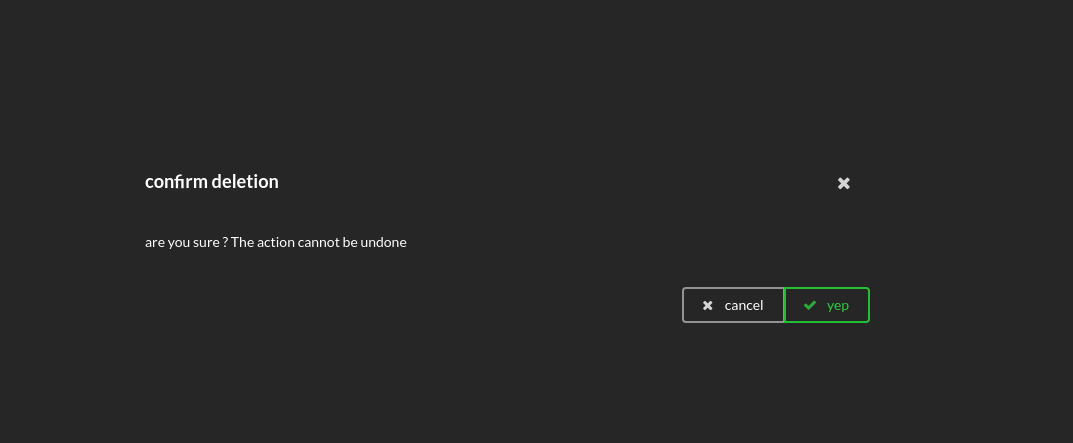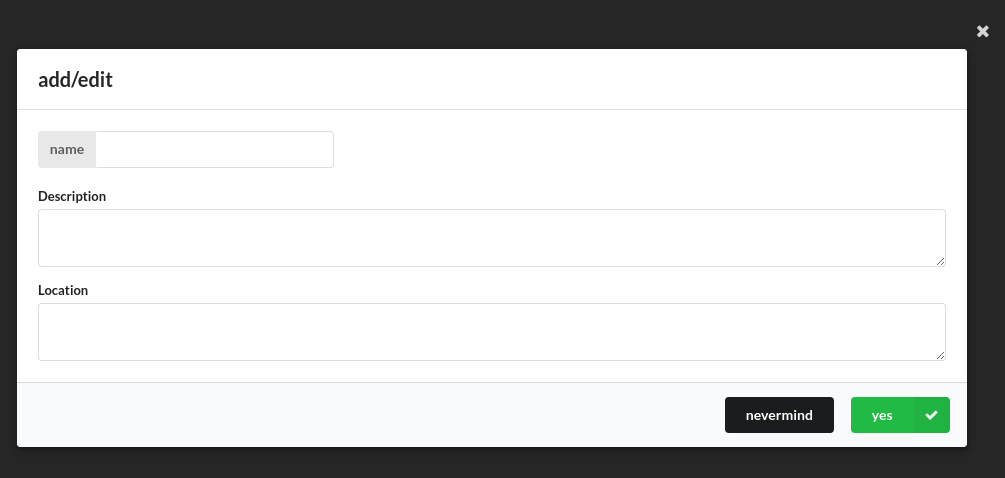AngularJS ModalService for the semantic-UI framework. Have a look at the demo.
- load the script to your page
- reference the module as a dependency to your angular app:
angular.module('app',
[
'semantic.modals',
// other dependencies
]);- In your controller, use the
ModalService:
angular
.module( 'app' )
.controller( 'MainCtrl', function(ModalService){
var self = this;
self.confirmModal = function(){
ModalService.showModal({
title : "confirm deletion",
text: "are you sure ? The action cannot be undone",
positive: "yep",
negative: "cancel",
basic: true
}).then( function( result ){
if(result.status){
console.log("deleting item...");
}
});
};
} );The result is :
bower install semantic-modals
showModals accepts the following options:
- title : the title of the modal,
- text : the content of the modal, as a simple text,
- html : the content of the modal, with html support,
- htmlInclude: the path to a file containing the content of the modal (uses
ng-includeinternally), - templateId: the id of a
ng-template, to use only when you need your own modal code, - templateUrl: the url of a file containing some ng-templates definitions, to use in conjonction with
templateId(note: if your template file contains only one template and the template ID is equal to the template url, you can leave this option blank), - positive, negative : the text of the negative/positive buttons. If not present, the button won't appear,
- basic : true/false, if true, the result will be a small basic modal, as presented in the semantic-ui examples,
- inputs : an object which will be passed to the modal controller. It means you can use whatever you register in the inputs in your modal content, using
inputs.myVarorinputs.myFunc(). But don't forget the modal is in an isolated scope, - cancelable : true/false, true by default. Whether or not clicking outside the modal closes it.
The showModal function returns a promise, which is resolved upon modal close and rejected in case the modal could not be instanciated.
The resolve callback takes one argument: {status: true/false, inputs: yourInputs}. The status is true if the use pressed the positive button, false otherwise.
The inputs argument is passed back and can have been modified. It is useful for dialogs with forms for example.
A confirm modal with html and inputs binding, no cancel button:
ModalService.showModal( {
title: "confirm",
html: "are you sure you want to delete {{inputs.sensor.name}} ({{inputs.sensor.id}} ) ?",
positive: "yes",
basic: false,
inputs : {
sensor: {id: 3, name: "merde"}
},
cancelable : true
} ).then( function( result ){
console.log( result );
}, function(){
console.log( "error" );
} );A modal using a partial:
ModalService.showModal( {
title: "edit",
htmlInclude: "html/_editModalContent.html",
positive: "yes",
negative: "nevermind",
basic: false,
cancelable : false
} ).then( function( result ){
console.log( result );
}, function(){
console.log( "error" );
} );// html/_editModalContent.html
<form name="editform" class="ui form" novalidate>
<div class="ui labeled input">
<!--name-->
<div class="ui label">
name
</div>
<input type="text" ng-model="inputs.name">
</div>
<!--description-->
<div class="field">
<label>Description</label>
<textarea ng-model="inputs.description" rows="2"></textarea>
</div>
<!--location-->
<div class="field">
<label>Location</label>
<textarea ng-model="inputs.location" rows="2"></textarea>
</div>
</form>A completely custom template:
<script type="text/ng-template" id="semanticModal.html">
<div class="ui modal small">
<i class="close icon" ng-click="close(false)"></i>
<div class="header">
edit {{inputs.sensor.id}}
</div>
<div class="image content">
<div class="description">
<form name="editform" class="ui form" novalidate>
<div class="ui labeled input">
<!--name-->
<div class="ui label">
name
</div>
<input type="text" ng-model="inputs.sensors.name">
</div>
<!--description-->
<div class="field">
<label>Description</label>
<textarea ng-model="inputs.sensor.description" rows="2"></textarea>
</div>
<!--location-->
<div class="field">
<label>Location</label>
<textarea ng-model="inputs.sensor.description" rows="2"></textarea>
</div>
</form>
</div>
</div>
<div class="actions">
<div class="ui black deny button" ng-click="close(false)">
Nope
</div>
<div class="ui positive right labeled icon button" ng-click="close(true)">
Yep, that's me
<i class="checkmark icon"></i>
</div>
</div>
</div>
</script>If the template is located in a file with the path identical to the template id (semanticModal.html):
ModalService.showModal( {
templateId: "semanticModal.html",
cancelable : false
} );If the template is in a file different from the id, say partial/templates.html:
ModalService.showModal( {
templateId: "semanticModal.html",
templateUrl: "partial/templates.html",
cancelable : false
} );

